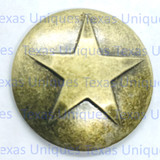Conchos come from the Mexican vaquero tradition and serve both a decorative and a utilitarian role on western saddles.
Conchos are metal disks, traditionally with two slits to allow saddle strings to pass through and secure the saddle’s skirts to the saddle tree. In this configuration, the concho is usually combined with a slightly larger leather rosette (also with two slits) that sits behind the concho to make the attachment snug.
Each end of the saddle string goes around the bars, through the skirts and through the concho. It’s then tied using the slit-braid method where one end of the string is fed through slots in the other end. The result is a very strong assembly with a finished look.
Today, only top-end saddles are made with the strings anchoring the skirt to the bars. With most saddles, the strings are simply tied to a small dee ring or fed through the conchos from the outside of the saddle. As a result you now see the solid style concho, used mainly for decoration, much more than you see the slotted concho.
Most often conchos are silver in color, made from sterling silver, or, more commonly today on factory saddles, made of nickel or silverplate over copper. Conchos are traditionally very decorative with engraved designs. You can find conchos in a wide variety of shapes and designs and used on apparel, hats, and belts in addition to saddles.
Source: http://www.western-saddle-guide.com/blog/2007/04/26/what-are-conchos/


